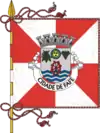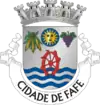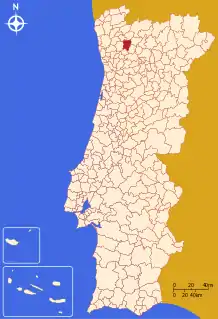Fafe
Fafe (Portuguese pronunciation: [ˈfaf(ɨ)] (![]() listen)) is a municipality in the northern Portuguese district of Braga. The population in 2011 was 50,633,[1] in an area of approximately (219.08 square kilometres (84.59 sq mi).[2] The city itself had a population of 14,144 in 2001.[3] The present mayor is Raul Cunha, elected by the Socialist Party. The municipal holiday is May 16.
listen)) is a municipality in the northern Portuguese district of Braga. The population in 2011 was 50,633,[1] in an area of approximately (219.08 square kilometres (84.59 sq mi).[2] The city itself had a population of 14,144 in 2001.[3] The present mayor is Raul Cunha, elected by the Socialist Party. The municipal holiday is May 16.
Fafe | |
|---|---|
 _(cropped).jpg.webp) _(cropped).jpg.webp) .jpg.webp) .jpg.webp) _(cropped).jpg.webp) _(cropped).jpg.webp) | |
 Flag  Coat of arms | |
 | |
| Coordinates: 41°27′N 8°10′W | |
| Country | |
| Region | Norte |
| Intermunic. comm. | Ave |
| District | Braga |
| Parishes | 25 |
| Government | |
| • President | Raul Cunha (PS) |
| Area | |
| • Total | 219.08 km2 (84.59 sq mi) |
| Population (2011) | |
| • Total | 50,633 |
| • Density | 230/km2 (600/sq mi) |
| Time zone | UTC±00:00 (WET) |
| • Summer (DST) | UTC+01:00 (WEST) |
| Website | http://www.cm-fafe.pt |
History
In the 10th century, King Ordoño III of León donated the Vila de Moraria (Moreira de Rei) and Monte Longo to the monastery of Guimarães, founded by the Countess Mumadona.[4]
The territory was effect the Diocese of Braga in the 12th century, and was one of the largest of the seven dioceses, with approximately 950 to 1000 civil parishes divided into 38 group.[4] During the 1220 Inquirições (Inquiries), the territory of Monte Longo was first identified. This location would have an effect; in 1258, the municipality was designated as the lands and julgado (judicial territory) of Monte Longo.[4]
By 1320, Fafe was part of the Diocese of Braga and the Terra de Entre Ave e Vizela, also known as the Terra de Montelongo, with 15 parochia, among which Santa Ovaia Antiga (Santa Eulália de Fafe).[4]
On 15 November 1514, King D. Manuel I conceded the first foral (charter) to the town of Fafe.[4] The 1527 Numeramento de D. João III (census of King John III), the parish of Samta Ovaya Antigua (Santa Eulália) had only 64 neighbours.[4]
It was only in 1647 that the first reference to the toponymy Fafe, and shortly thereafter (1655) the parish adopted the name Santa Eulália de Fafe.[4]
In 1706, the donatário of the town of Fafe and municipality of Montelongo was the Count of Vimieiro. By mid-century, though, in 1758, the Memórias Paroquiais (Parochial Memories) described that the donation was attributed to the Marquis of Valença, D. Miguel de Portugal e Castro.[4]
Between 1907 and 1986 Fafe was served by the narrow-gauge trains of the Guimarães line. The railway is now closed between Guimarães and Fafe.
Geography
The municipality is situated in a valley.
Administratively, the municipality is divided into 25 civil parishes:[5]
- Aboim, Felgueiras, Gontim e Pedraído
- Agrela e Serafão
- Antime e Silvares (São Clemente)
- Ardegão, Arnozela e Seidões
- Armil
- Cepães e Fareja
- Casa do Substimado
- Fafe
- Fornelos
- Freitas e Vila Cova
- Golães
- Medelo
- Monte e Queimadela
- Moreira do Rei e Várzea Cova
- Passos
- Quinchães
- Regadas
- Revelhe
- Ribeiros
- Santa Cristina de Arões
- São Gens
- São Martinho de Silvares
- São Romão de Arões
- Travassós
- Vinhós
Architecture
Civic
- Fafe Comarca Jailhouse (Portuguese: Cadeia Comarcã de Fafe/Posto da Guarda Nacional Republicana, GNR, de Fafe)
- Municipal Palace/Hall of Fafe (Portuguese: Câmara Municipal de Fafe/Paços do Concelho de Fafe)
Religious
- Chapel of Prata (Portuguese: Capela da Prata)
- Chapel of Nossa Senhora da Ajuda (Portuguese: Capela de Nossa Senhora da Ajuda)
- Chapel of Nossa Senhora da Conceição (Portuguese: Capela de Nossa Senhora da Conceição)
- Chapel of Nossa Senhora do Desterro (Portuguese: Capela de Nossa Senhora do Desterro)
- Chapel of Nossa Senhora das Graças (Portuguese: Capela de Nossa Senhora das Graças)
- Chapel of Nossa Senhora da Guadalupe (Portuguese: Capela de Nossa Senhora de Guadalupe)
- Chapel of Nossa Senhora de Lourdes (Portuguese: Capela de Nossa Senhora de Lourdes)
- Chapel of Nossa Senhora do Socorro (Portuguese: Capela de Nossa Senhora do Socorro)
- Chapel of Santa Bárbara (Portuguese: Capela de Santa Bárbara)
- Chapel of Santa Luzia (Portuguese: Capela de Santa Luzia)
- Chapel of Santa Marinha (Portuguese: Capela de Santa Marinha)
- Chapel of Santa Rita (Portuguese: Capela de Santa Rita)
- Chapel of Santo Amaro (Portuguese: Capela de Santo Amaro)
- Chapel of Santo André (Portuguese: Capela de Santo André)
References
Notes
- Instituto Nacional de Estatística
- "Áreas das freguesias, concelhos, distritos e país". Archived from the original on 2018-11-05. Retrieved 2018-11-05.
- UMA POPULAÇÃO QUE SE URBANIZA, Uma avaliação recente - Cidades, 2004 Archived October 6, 2014, at the Wayback Machine Nuno Pires Soares, Instituto Geográfico Português (Geographic Institute of Portugal)
- Vale, Rita (2012), SIPA (ed.), Núcleo urbano da cidade de Fafe (IPA.00028173/ PT010307090111) (in Portuguese), Lisbon, Portugal: SIPA – Sistema de Informação para o Património Arquitectónico, retrieved 16 April 2017
- Law nr. 11-A/2013 Reorganização administrativa do território das freguesias (pdf) (in Portuguese), Diário da República, pp. 552–(47), retrieved 22 July 2014
Sources
- Azevedo, Carlos Moreira; Jorge, Ana Maria; Rodrigues, Ana Maria (2000), História Religiosa de Portugal, Rio de Mouro (in Portuguese), 1, Círculo de Leitores, SA, p. 155
- Capela, José Viriato (2003), As freguesias do distrito de Braga nas Memórias Paroquiais de 1758 (in Portuguese), Braga, Portugal, p. 284
- Coimbra, Artur Ferreira (1997), Câmara Municipal (ed.), Fafe, A Terra e a Memória (in Portuguese), Câmara Municipal de Fafe, Portugal
- Costa, Carvalho da (1706), Corografia Portuguesa (in Portuguese), Tomo I, Lisbon, Portugal, p. 157